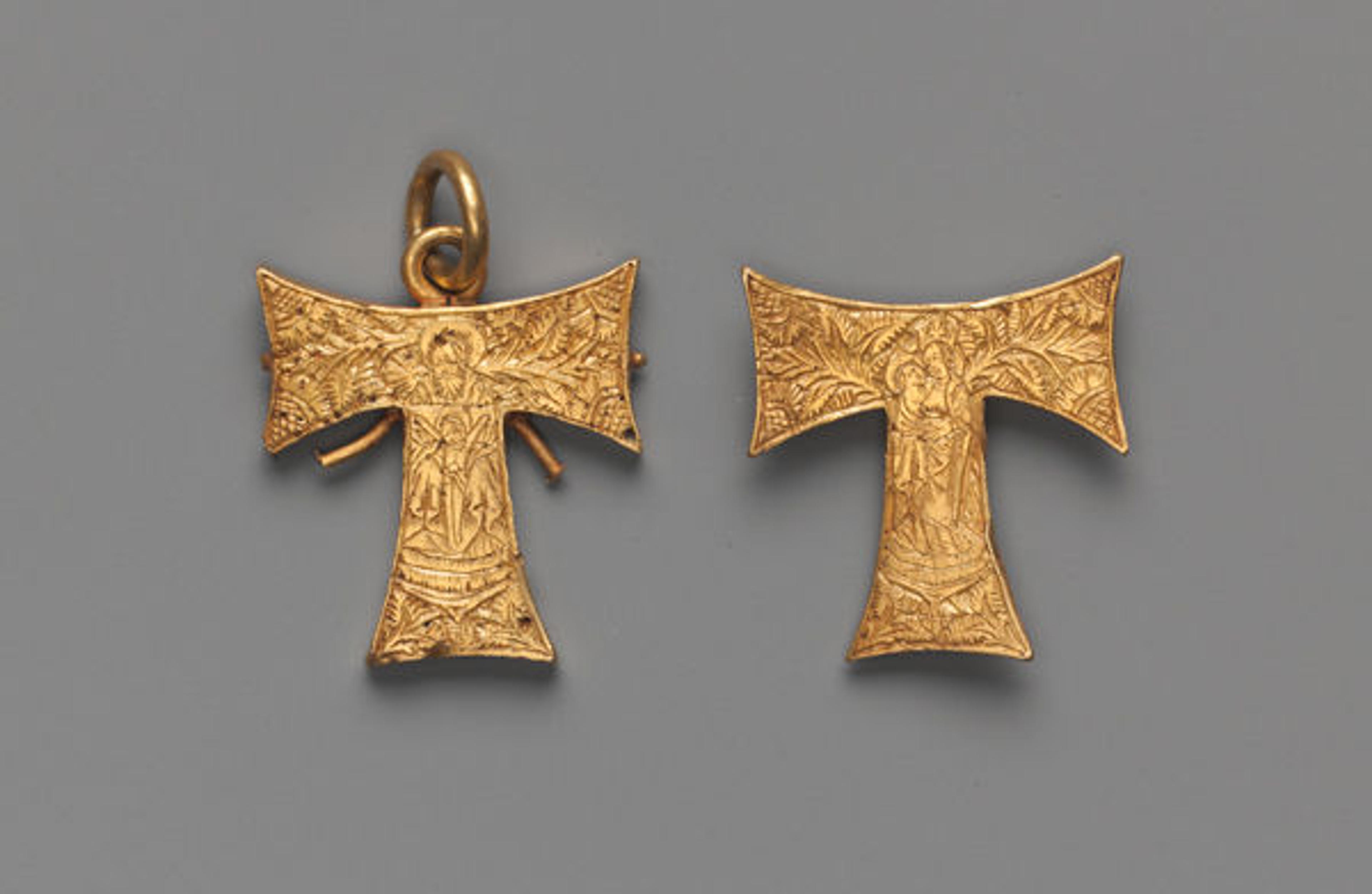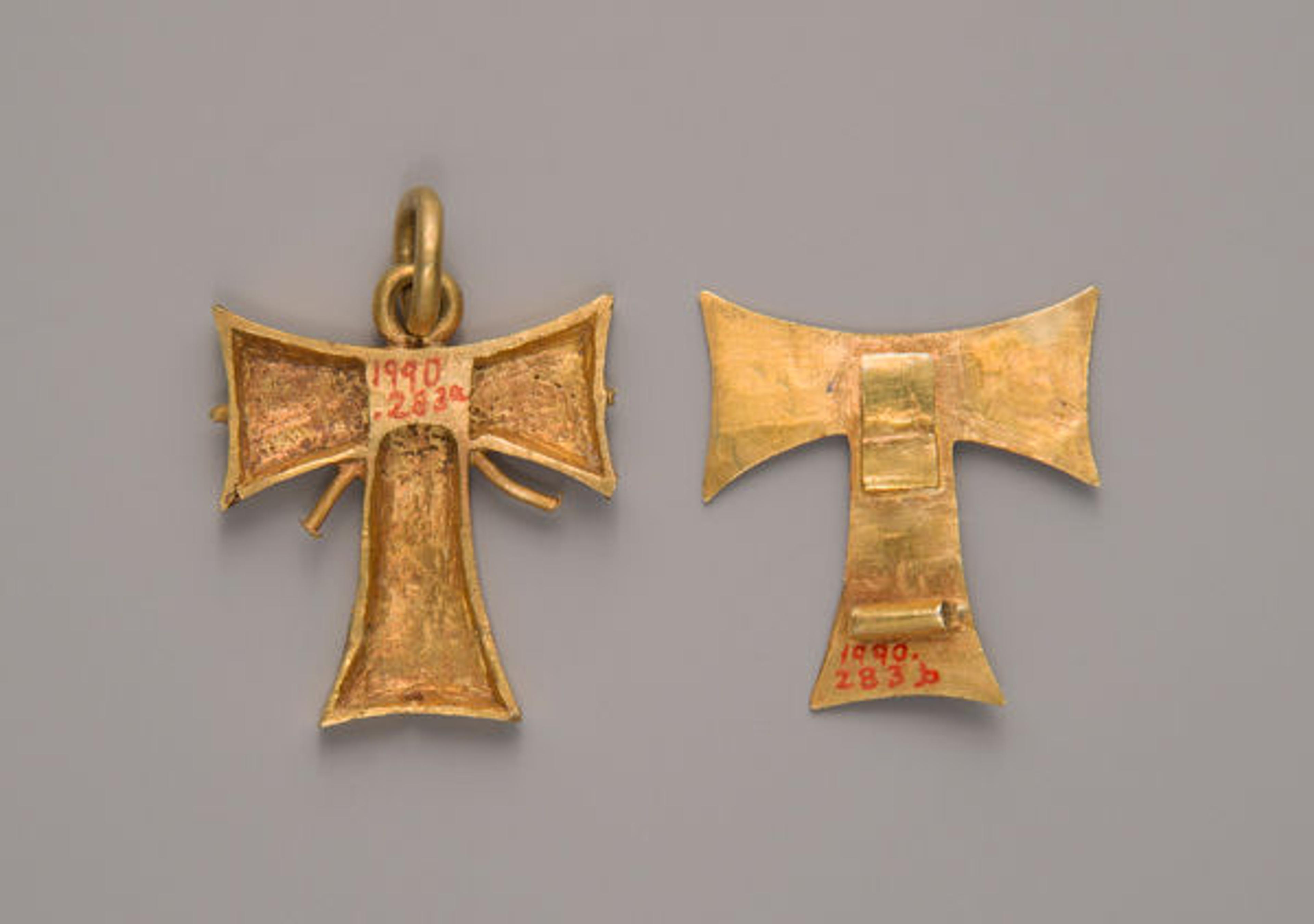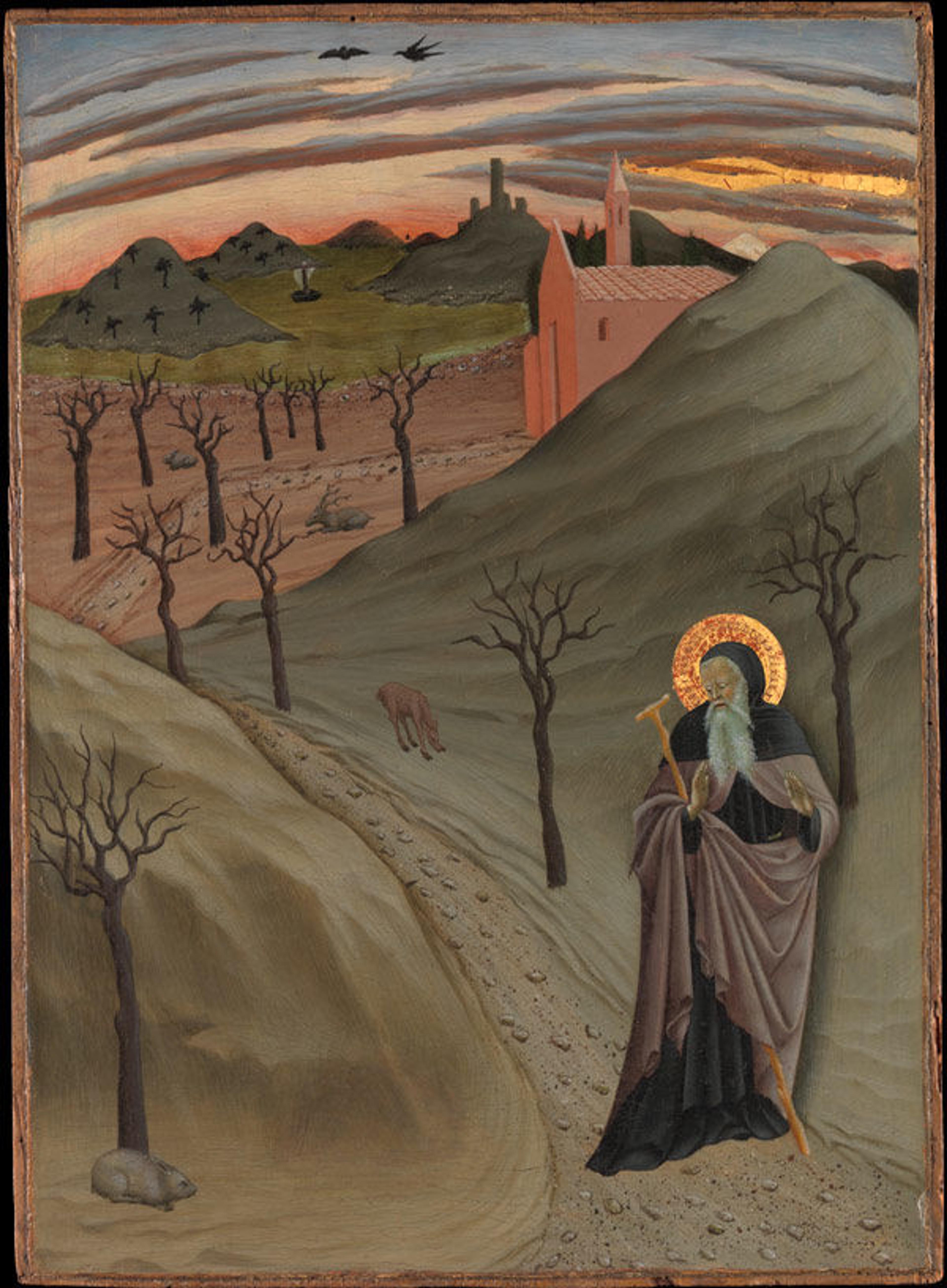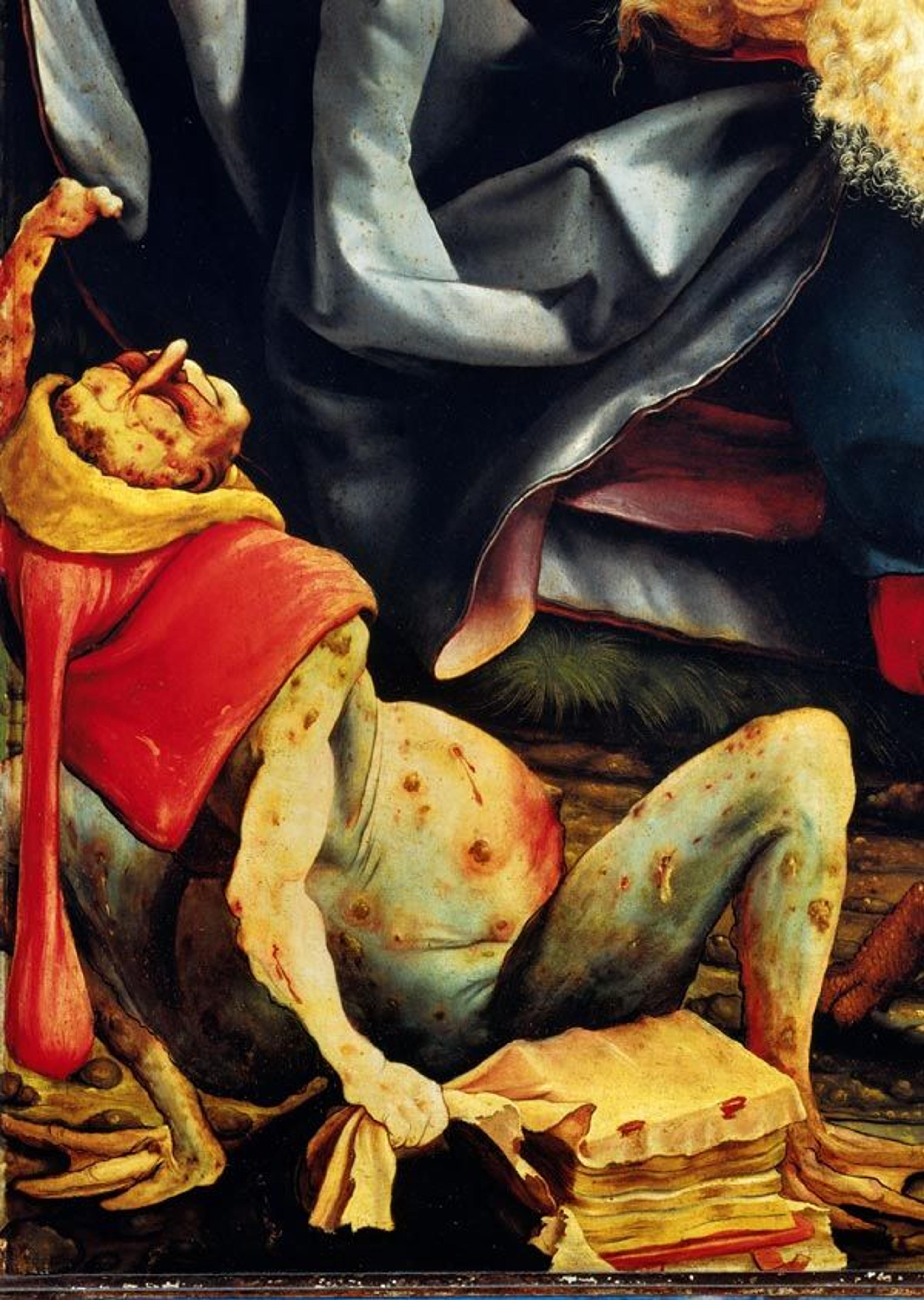Rye Gone Awry

Rye (Secale cereale) in florescence. Photograph by Wilson Santiago
«Caleb Leech, managing horticulturalist at The Cloisters museum and gardens, recently wrote a post for In Season entitled "Successful Secale," in which he discussed the use of rye (Secale cereale) in the Middle Ages. Rye was considered humble and undesirable during Roman and early medieval times, but because it thrived in poor soil and harsh conditions, it became widespread throughout Europe and was considered the basis of an excellent bread by the fourteenth century. Its widespread use, however, brought darker consequences—which will be shown in highlighting another object from The Cloisters Collection.»

Pendant capsule in the form of a tau cross, with the Trinity and the Virgin and Child (front and back), ca. 1485. British. Cast and engraved gold; H. 1 1/8 in. (2.8 cm). The Metropolitan Museum of Art, New York, The Cloisters Collection, 1990 (1990.283)
In 1990 The Cloisters acquired a small (2.8 cm in height), gold pendant cross in the shape of the Greek letter tau (ταυ). It was found with the use of a metal detector in a field at Winteringham, South Humberside, in North Lincolnshire, England, and subsequently sold at auction by Sotheby's in London. At the top of the object are a loop and a ring for suspension, and two posts project from the lower joins of the arms and the upright; each once held a pearl, which have disintegrated in the earth. Engraved on the front is the Trinity: God the father, who is seated on a throne and holds the crucified Christ on a tau-shaped cross between his knees (a composition known as the Throne of Mercy), while the dove signifying the Holy Spirit appears just to the left of God's head. On the back side, the crowned Virgin holding the Christ Child stands on a crescent moon. Both groups are set on brackets against a background of leafy branches that terminate with cross-hatched fruit or blossoms in the corners of the arms.

Pendant in form of a tau cross (1990.283), interior front and back
The pendant was fashioned as a capsule, with the facing piece cast as a walled container about one-eighth of an inch in depth. The back serves as the cover plate, and the inside face is fitted with a flanged tongue which slides underneath the plate soldered to the interior of the front piece. The back is held in place by a latten pin which passes through a tube soldered to the inside of the back plate.
Two questions immediately arise when viewing this cross: What did the letter tau signify in the Middle Ages, and what was the function of this pendant capsule in the shape of a tau?

Plaque with marking of the door with the letter tau, ca. 1200. German. Champlevé enamel, copper alloy, gilt; 2 9/16 x 2 15/16 in. (6.5 x 7.5 cm). The Metropolitan Museum of Art, New York, Gift of J. Pierpont Morgan, 1917 (17.190.438)
In medieval imagery, the tau was a protective sign that Aaron painted in blood on the upper doorposts of Israelite houses on the night of Passover [Exodus 12:1] and thus was understood as a symbol of salvation. The tau was also the sign marked in ink on the foreheads of the righteous of Jerusalem so that they would be recognized and spared destruction by God [Ezekiel 9:4]. In typological arrangements, this scene was juxtaposed with that of Christ Carrying the Cross. The tau was also used as the model for the cross itself; the two thieves who flank Christ at the Crucifixion are often shown on tau crosses, and Christ himself is on a tau-shaped cross in representations of the Throne of Mercy, such as the one seen on the front of the pendant cross in the Museum's collection. The staff upon which Moses lifted up the Brazen Serpent was also represented in the form of a tau cross and was understood to foreshadow the Crucifixion. The tau cross also symbolized Advent and, by extension, eternal life in Christ.
By the later Middle Ages, however, the tau cross became primarily associated with Saint Anthony Abbot, a fourth-century Egyptian who established a monastery in the Fayum but who led a largely hermetic life in the mountain wilderness. The tau cross came to signify his abbatial authority.

Osservanza Master (Italian, active second quarter 15th century). Saint Anthony the Abbot in the Wilderness, ca. 1435. Tempera and gold on wood; 18 3/4 x 13 5/8 in. (47.6 x 34.6 cm). The Metropolitan Museum of Art, New York, Robert Lehman Collection, 1975 (1975.1.27)
The relics of Saint Anthony are thought to have been transported in about 1070 from Constantinople to the parish church of Saint-Didier-la-Mothe, in the foothills of the Dauphiné in southwestern France. According to tradition, a hospice was established nearby in 1095 which eventually became the central house of the Order of the Hospitalers of Saint-Antoine-de-Viennois, known commonly as the Antonines. Early in the thirteenth century, the Antonines built a chapel adjoining the hospital. In 1231 statutes for the order were drawn up putting a grand master in charge of each dependent house, or commandery. In 1247 the Antonines adopted the rule of Saint Augustine, and the original priory was elevated to the rank of abbey and converted to an order of Augustinian canons. Antonine foundations soon spread throughout France, Spain, Italy, Germany, England, and the Near East.

Devoted largely to the care of the sick, the Antonines wore a black habit emblazoned with a large tau cross. Saint Anthony is often represented with a pig, thought to have originally symbolized the saint's conflicts with evil spirits. By the later Middle Ages, the Antonines obtained the privilege of allowing their pigs to run loose. Bells were tied to their necks to identify them and it was considered meritorious to feed them; thus bells, along with pigs, came to symbolize the order.
Left: Anonymous German, 15th century. Detail of Saint Anthony, from Saints Anthony, Sebastian, and Christopher, ca. 1470–90. Metalcut with dot punch, hand-colored; laid down on wooden cover; 10 15/16 x 6 5/16 in. The Metropolitan Museum of Art, New York, Bequest of James C. McGuire, 1931 (31.54.112)
Medieval hospitals, such as those run by the Antonines, served a variety of functions vital to the very fabric of medieval society. More multipurpose facilities than today's counterparts, medieval hospitals served not only as caregivers to the sick but variously as shelters for the poor and homeless, residences for indigent students, clinics, dispensaries, hostels for pilgrims, leprosaria, orphanages, old-age homes, and refuges for the blind.
From an early date, Antonine hospitals specialized in the treatment of victims of an endemic disease that came to be known as Saint Anthony's fire, or ignis sacer. This disease—or plague, as it was thought to be—sporadically broke out across Europe with inexorable virulence from the eleventh century onwards. The horrific symptoms included agonizing intestinal pain, hallucinations accompanied by muscle spasms, and violent contortions. The common name of the disease derived from the burning sensations in the extremities, which eventually turned gangrenous, withered, and ultimately required amputation. Victims were often depicted with flames shooting from their hands and feet (see the detail of Saint Anthony at left; the presence of flames here suggests that Saint Anthony protected against, rather than suffered from, the disease). Once contracted, the disease was progressive, relentless, and incurable.
A grotesque figure appears in the lower left corner of the scene of Saint Anthony tormented by demons in the Isenheim Altarpiece, painted by Mathis Gothart Nithart (Grünewald) from 1512 to 1516 for the hospital chapel of the monastery of Saint Anthony in the town of Isenheim, near Colmar in the Alsace region of France. This wretched soul—whose bloated body is covered with angry pustules, whose limbs are gangrenous, and whose left hand is largely missing—is thought to represent a victim, in extremis, of Saint Anthony's fire.

Mathis Gothart Nithart (Grünewald) (German, 1475/80–1528). Detail of right inner wing of the Isenheim Altarpiece, Saint Anthony Tormented by Demons. Oil and tempera on limewood panel. Museé d’Unterlinden, Colmar. http://www.musee-unterlinden.com/isenheim-altarpiece.html Image courtesy of Scala/Art Resources, NY
The devastating effects of the disease occasionally reached proportions matched only by outbreaks of bubonic plague. A single outbreak in Paris in 1418 claimed fifty thousand lives in a single month; other serious outbreaks occurred in 1473, 1474, 1494, and 1509.
Medicine in the Middle Ages was purely palliative, not curative, and in the case of Saint Anthony's fire, the populace was all the more terrorized because the disease seemed to strike in a ubiquitous and random manner. Isolated rural towns often spared by the Black Death knew no respite from Saint Anthony's fire. Because a cure was inconceivable, the Antonine hospitals could only attempt to alleviate the symptoms and to prepare the patient for the inevitable. Having no understanding of the nature of the disease, the means of contracting it was viewed as a matter of divine governance: Man was being stricken for his sins.
By the end of the fifteenth century Antonine hospitals devoted themselves exclusively to the care of patients diagnosed with Saint Anthony's fire. The more common therapies relied on a variety of plants and herbs, particularly those thought to accord with the dry and cold humors such as plantain, poppy, sage, and verbena—all of which were viewed as allopathic remedies that reduced the inflammation and eased the burning sensation of the disease. Another widely used concoction, known as saint vinage, was a fortified wine with a blend of macerated herbs into which relics of Saint Anthony had been dipped.
Only in 1676 was the cause of Saint Anthony's fire, known by modern medicine as ergotism, discovered to be the consumption of grain—particularly rye—that had been contaminated by the mold claviceps pupurea. The disease could have readily been cured by modern-day penicillin. Disadvantaged of this knowledge, however, the original owner wore our pendant tau cross around the neck and filled its interior cavity with a relic of Saint Anthony or an amuletic compound, in confident faith that a higher power would provide protection against this fearful disease.

Rye infected with claviceps pupurea. Photograph by Andrew Winslow
Related Link
In Season: Successful Secale
Tim Husband
Tim Husband is a curator in the Department of Medieval Art and The Cloisters.